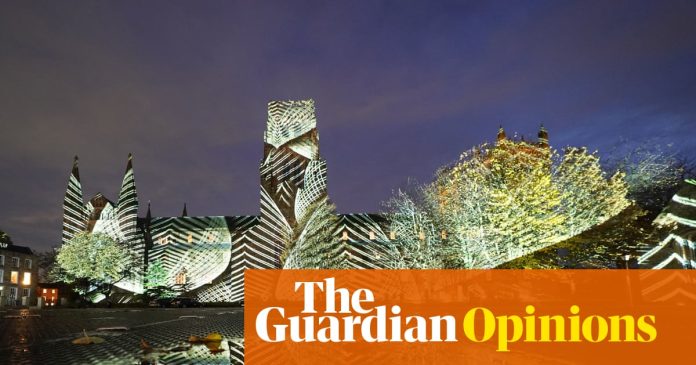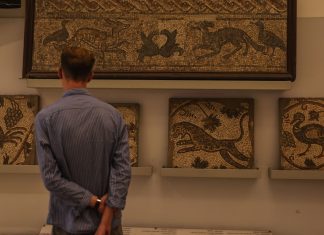Durham is a small, beautiful city in the north-east of England that sits in a region of rising poverty and inequality. About 45,000 people, a cathedral, a castle, a university and streets that glow every two years when the Lumiere festival fills them with light and art.
Since 2009, Lumiere has brought more than 250 artists from across the world to work in this extraordinary city. Ai Weiwei in the Cathedral’s Chapter House. Fujiko Nakaya on the riverbank. Chila Kumari Singh Burman in the market square. The festival has reached more than 1.3 million people, drawn £43m into the local economy, and involved nearly 14,000 people in community projects. It worked because it was free, exciting and good. A rare combination.
And now it’s over. After 15 years, the lights go out on Lumiere Durham. And with it goes one more piece of the UK’s cultural fabric.
The arts sector is crumbling. We’ve lived through decades of neglect. The system that’s meant to support it is broken. Artists are exhausted, Arts Council England follows policy rather than shaping it. Government investment in ACE has fallen by 32% in real terms since 2010. Its main grant-giving platform collapsed and was out of action for four months this year. When Jaguar Land Rover suffered a cyber-attack, the Treasury stepped in with a £1.5bn loan. When the Arts Council site went down, the government offered technical advice but no cash.
Local authorities are broke too. Years of central funding cuts have left them with impossible choices. Social care or sculpture? Bin collections or ballet? We all know what gets dropped when those are the choices.
And as we head towards the autumn budget on 26 November, little has been said about what support will be offered to the arts. Industry bodies and campaigners are warning that the coming budget could be a tipping point. Without targeted investment, many organisations will not survive the next financial year. Business rates relief for cultural buildings is due to end. The Shared Prosperity Fund, which replaced EU regional support, is winding down. Local authorities, already on their knees, face further real-terms cuts.
Meanwhile, UK Research and Innovation spends less than 2% of its budget on the arts and humanities. Trusts and foundations around the country are closing or turning away new arts applicants. And yet the government finds half a billion pounds for three major sporting events – the Euros, the Tour de France, and the European Athletics Championships – and another £400m for “grassroots facilities”. Culture Secretary Lisa Nandy said: “Sport tells our story in a way few other things can.”
I would strongly argue that it’s the arts that tells our story. It helps us understand who we are and it’s what has always connected us, across time and place. In Durham, for a few nights every two years, the streets are filled, not with division or anger, but with light, laughter and quiet awe. People stand side by side, strangers together, looking up. That’s what art can do.
So why has Lumiere ended?
It would be easy to blame the new Reform-led council in Durham. But the previous LibDem/Tory coalition started the process. And this government has just cut bursaries to trainee teachers in humanities subjects. The truth is, there is no political party that will commit to the kind of investment needed to keep a living art and culture ecology alive, despite the huge returns in financial and culture value.
So where does the real fault lie? With all of us. With the arts community that has failed to convince politicians and the Treasury that art is not a luxury but a public service. And with the wider public who don’t make this an electoral issue.
The numbers are there in spades. The arts and culture industry contributes more than £10bn annually to the UK economy and £2.8bn each year to the Treasury through taxation, alone.
You can and should count jobs, exports, return on investment and audience numbers. But you can’t count what it feels like to stand in a crowd and be moved, you can’t quantify wonder, inspiration or joy. That’s what we’ve lost.
We talk about “funding” as if it’s a favour. It’s not. It’s investment in imagination, in shared experience and in our national story. We invest in trains, hospitals, and clean water because we know they’re essential. Art is essential too.
The budget later this month could show whether the government understands that, or not. Sector leaders are calling for a new national arts recovery plan. Not charity but public investment on the same footing as sport or science. Even a small commitment would send a signal that culture matters, that it’s part of how we rebuild our economy and communities.
That argument appears to have been lost long ago with Whitehall. But not, it seems, in Durham. People there understood. They came, year after year, in the rain and the cold, to stand together in the light, unified by art. Now the lights are out and what are they left with? Flags and banners?
And unless something changes, Lumiere won’t be the last to go dark.








